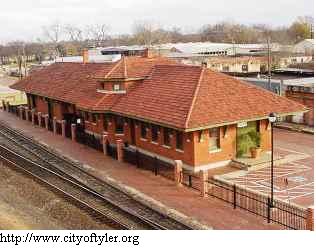Smith County lies on the western boundary of Eastern Texas. The county seat is Tyler. Caddo Indians lived on the land until disease and warfare pushed the Indians out of the area. The Texas Legislature partitioned land from the Nacogdoches District and created Smith County in 1846 in honor of General James Smith, a soldier in the Republic of Texas.
During the 1850s, population and production 
The county's infrastructure changed after the war, which resulted in the loss of jobs and increased racial tension. The economy stabilized through the farming of corn and cotton, the introduction of timber mills, and railroads, which allowed the exporting of items. Over-dependence on land depreciated cotton production, but the cultivation of roses held steady and became a landmark for the county.
The New Deal programs such as Civilian Conservation Corps helped to aid the county's economy and helped in the construction of Tyler State Park. The discovery of oil added wealth to Smith County, as people migrated from other areas to work the rigs. Through land preservation, the price of land increased during the rest of the century, and farmers transitioned to utilizing timber to increase income. Tyler became a focal point for education and medicine with the University of Texas-Tyler.
Museum/Historic Site
- Bonner-Whitaker McClendon House, The/McClendon Historic Estate
- Brookshire's World of Wildlife Museum and Country Store
- Camp Ford
- Carnegie History Center
- Cotton Belt Train Depot
- Dewberry Plantation
- The Discovery Science Place
- Goodman Museum
- Historic Aviation Memorial Museum
- Smith County Historical Society Museum and Archives
- Tyler Rose Garden and Museum
- Tyler Museum of Art
- Tyler State Park
Genealogy
- Captain James P. Douglas Chapter, Camp 124, SCV
- Captain William Barron Chapter 25, SAR
- East Texas Genealogical Society
- Mary Tyler Chapter, DAR
- Mollie Moore Davis Chapter 217, UDC
- Thomas Abraham Carter Chapter 2549, UDC
- Troup Genealogical-Historical Society, Inc.
News Articles
- (March 18, 2013) East Texans bring attention to forgotten Smith County cemetery
Documents/Resources
- Books
- Chronicles of Smith County, Texas; Newsletter- Smith County Historical Society/Historical Commission (Journals)
- 1990 Census of population and housing (Map)
- Amnegro: the American Negro magazine; Tyler city directory (Serial)
- University Archives and Special Collections; UT-Tyler
Text: http://www.tshaonline.org/handbook/online/articles/hcs11 Handbook of Texas Online, Texas State Historical Assoication.
To learn more about Smith County's history check out Local Voices' writer Marvin Mayer's column "Plain Truths about Smith County" on our Local Voices page.